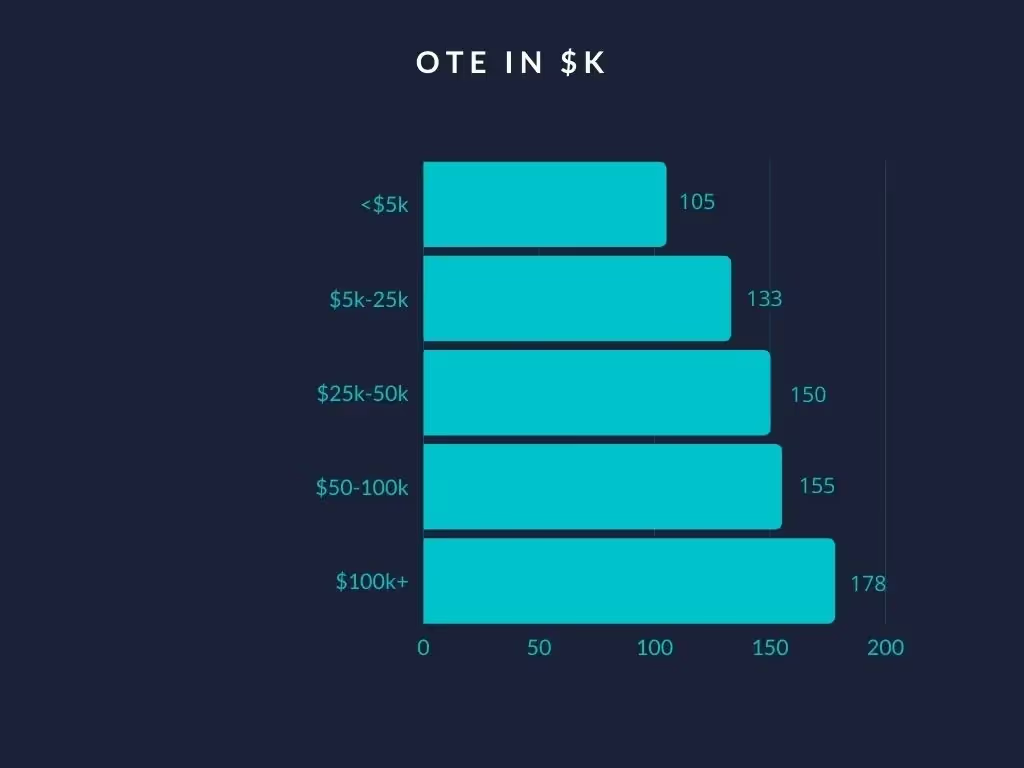Quota-to-OTE ratio is a key sales compensation metric that helps align rep motivation with business goals and varies based on company specifics—there’s no universal answer.
- Dig into benchmarks and expert opinions, but recognize that context matters for your business.
- Avoid rookie mistakes by understanding the details behind different ratio recommendations.
- Balance attractive OTEs with achievable quotas to drive productivity and retain top talent.
As an analyst, when I first stepped into the SaaS space, I wanted to understand EVERY single metric/benchmark associated with it (beginner’s enthusiasm, I know) and then compare them with my company’s metrics. After reading through scores of articles, I figured that there are two kinds of people in SaaS: people who swear by benchmarks shared by SaaS gurus like Jason Lemkin & David Skok (including yours truly) and skeptical peeps who may not.
Initially, I studied the two perspectives in their extremes and wondered why there was so much difference of opinion. What a rookie mistake! Only later did I realize that despite starkly opposite opinions, neither of the two groups was wrong and the devil usually lies in the details. Same goes out for when you’re trying to derive the right quota-to-OTE ratio for your sales reps. There’s no single right answer and the number depends on the finer details.
In this blog, we’ll pay close attention to the details and hope to find the devil. Read on.
What does Quota-to-OTE ratio mean?
Here’s the math to keep in mind:
- OTE (On-target Earnings) = Base Salary + Commissions at 100% quota achievement for the year.
- Say, the rep carries a $750K ARR quota for a year and the OTE is $150K.
- Quota-to-OTE ratio = $750K/$150K = 5X
Why is it relevant?
First off, sales productivity and quota per rep have a direct impact on sales costs. Second, the offered OTE could be a deciding factor for prospective employees contemplating on whether to join your company. However, bear in mind that they’ll remain motivated only if they are able to achieve the quota offered. Setting unrealistic quotas could lead to reps losing morale. We cannot stress enough on the importance of striking the right balance between employee motivation and the bottom-line.

So, what is the right Quota-to-OTE ratio?
I can certainly say it isn’t 42 😅. There isn’t a universal answer (for the clueless ones, here’s the reference). The general thumb rule is the quota being 4x-6x of OTE. Note that this approach holds good only in specific contexts. Thumb rules are helpful, yes, but it’s also essential to understand the context in which they are appropriate. Do not take them at face value.
Now, to figure out a suitable quota-to-OTE ratio for your business, I’ve jotted down a few Qs for you to ponder upon. Answering them and looking at the whole picture will help you arrive at the right OTE and quotas.

Q#1 Business & go-to-market model: Are you a SaaS business with recurring revenue?
Q#2 Business & go-to-market model: Is your approach inbound-driven (SEM+SEO) with an inside sales team or outbound-driven (SDR+Sales) with a field sales team? Factor in the marketing spends required to support the specific go-to-market model.
Q#3 Roles: Are you defining the ratio for account executives selling to new accounts or account managers responsible for account expansion? Customer acquisition costs are higher compared to customer retention and expansion. Non-sales functions may not even have bookings/revenue-related quotas.
Q#4 Geography: Are reps located in the same geography as the prospects and customers? Field sales reps have higher salaries than inside sales reps.
Q#5 Average Contract Value: Which customer segment(s) are you targeting? The higher the ACV, the higher would be the OTE and quota.
Q#6 Brand recognition in the market: Is your company a market leader or an upcoming brand trying to establish a presence? For early-stage companies, hiring the best reps would mean paying competitive market salaries even though the quota has to be lower than benchmarks.
Now that you’ve answered the above questions, let’s look at a few scenarios:
- If you have a non-SaaS business model, your entire revenue would be recognized upfront (depending upon the average deal size and contract tenure). Therefore, the quota could be 6-10x of OTE.
- If you are a B2B SaaS business model, ratios for each role can be as follows:
- Quota for field sales account executives focusing on new logs through outbound efforts can be at 4-6x.
- Account managers with an ARR expansion target can have their quota go as high as 8x of OTE after factoring the upsell contribution to their revenue targets.
- Inside sales reps can find their quota anywhere between 4-8x depending on the reps location, average deal size and the additional marketing investments required to support the inbound efforts.
- For inside sales teams that are based in India or Asia and are selling remotely to customers in other geographies, the Quota-to-OTE ratio would just be a vanity metric. In such scenarios, it’s better to stick to conversion rates across the funnel and check for improvement opportunities.
The following charts from a survey conducted by The Bridge Group can also provide a helpful baseline for setting OTE & Quota based on ACV.


Closing Thoughts
While metrics and benchmarks can be valuable guideposts, they won’t be the end-goal or business objective in most situations. If you catch yourself questioning whether you have the right OTE and quota numbers, here’s a helpful heuristic:
- Are you able to attract top talent in a competitive market and hire your planned headcounts on time?
- Are your reps motivated & whether two-thirds of them achieve their quota?
- Are your top reps making enough to drive a Tesla Model S or an M8 convertible?
If your answers to the above questions are all yes, kudos! You’ve pretty much hit the nail on the ratio.
Now, a fully integrated and powerful quota manager is all you need to truly automate your commissions process. Schedule a demo with us today.
Acknowledgements: Thanks to Samra Taban for editing the blog and Aravindh Natesan for the designs.


%2520Quota-to-OTE%2520Ratio_%25402x.avif)





.avif)



